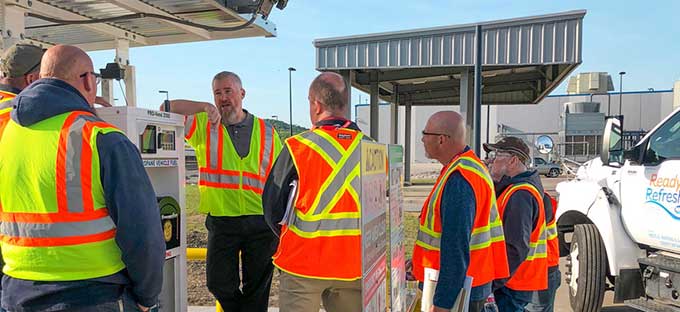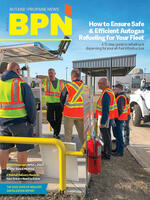
With the advent of propane autogas as the cleanest alternative fuel for fleets of all sizes also comes the need for refueling training that is properly outlined by the propane marketers that are working directly with those fleets. Refueling propane autogas vehicles is a quick and easy process, but it is critical that fleets are familiar with the equipment, how to properly use it and what actions are vital to fueling safely.
When purchasing propane autogas equipment for a fleet or assisting the fleet with the company’s purchase, it is important to utilize equipment that meets National Fire Protection Association (NFPA) requirements and is certified by Underwriters Laboratories and/or Measurement Canada and National Type Evaluation Program.
Mass flow meters, K15 nozzles and cloud-based software options all offer customers accuracy, reliability, safety and ease of use when implementing a propane autogas program. Propane autogas dispensers work in the same way as gasoline and diesel systems, but there are a few differences that are important to note when refueling. Propane autogas dispensers are closed, pressurized systems that keep propane in its liquid state, and the dispensers utilize a nozzle with a closed, threaded connection to maintain pressure while refueling.
As with any fuel, taking safety into account should be the most important priority. Safety measures for refueling with propane autogas include:
- Keep the dispensing area clear, except for objects necessary for dispensing.
- Vehicle ignition must be off before dispensing.
- All ignition sources must be a minimum of 25 feet away from the refueling site.
- Do not strike matches or light a cigarette lighter, and do not smoke.
- Avoid sources of static electricity.
- Do not use mobile phones.
- Report any propane leaks immediately.
- Follow the NFPA 58 code requirement by having at least one easily accessible fire extinguisher at the fueling site. (Fire extinguishers are not intended to put out propane fires, but they are effective for small fires and can be helpful in creating an escape route for personnel.)
With ample consideration of these safety measures, the following steps ensure safe propane autogas dispensing:
- Turn off the vehicle.
- Know personal protective equipment (PPE) requirements and follow them.
- Ensure there are no open flames or other ignition sources within 25 feet of the vehicle refueling.
- Open the fuel door and then unscrew the dust cap from the fill valve.
- Check the seal, gasket or O-ring for any tears, breaks or cuts. If damaged or missing, do not dispense until replaced.
- Remove nozzle from the dispenser.
- Screw the nozzle tightly on the fill valve, ensuring a proper fit. An improper fit could cause a leak.
- Activate the dispenser. This varies by the type of equipment being used and is usually conducted with a push of the start button.
- Pull the handle on the dispenser nozzle to start fueling. When the fuel level in the tank reaches 80% storage capacity, the fuel flow will automatically stop. Once again, this varies by the equipment.
- Release the handle, and then deactivate the dispenser (varies by equipment).
- When you release the handle and/or unscrew the nozzle, a small release of autogas vapor may occur. After unscrewing the nozzle, return the nozzle to the dispenser, replace the cap on the fill valve and shut the fuel fill door.
- If applicable, record refueling information.
Proper training is essential to a fleet’s implementation of a propane autogas program. Equipment manufacturers are more than willing to walk alongside propane marketers to provide extensive dispensing training, including one full day of classroom instruction and one full day of hands-on learning at a propane autogas station.
The combination of this training, along with the industry-specific materials provided by the Propane Education & Research Council, is the most effective combination to set up a propane autogas fleet for refueling success.




